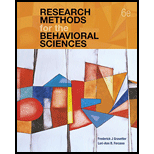
In addition to the key words, you should also be able to define each of the following terms:
target population
accessible population
law of large numbers
sampling methods, or sampling techniques, or sampling
procedures
simple random sampling
systematic sampling
stratified random sampling
proportionate random sampling
proportionate stratified random sampling
cluster sampling
convenience sampling
quota sampling
To explain the meaning of all the terms related to sampling.
Explanation of Solution
Target population: includes all the units on which the research results can be applied. It is not important whether the researcher is able to approach them or not. Target population includes all the individuals who are referred to in the research, or whom the research is applied.
Accessible population: It is the part of the target population which is approachable by the researcher. For example, if we say all college students in the state form the population for this research, then the researcher can access students of the state university. These students of the state university which are accessible by the researcher become the accessible population for the research
Law of large numbers: this law deals with repeating an experiment several times. It deals with the large number of trials. Accordingly, if an experimented several times, then the average of the outcome is close to the expected value. For example, if a coin is tossed 10000 times, the probability of getting head would be very close to 0.5. it is a promising law, that works well in statistics.
Sampling methods: These are the different ways in which samples can be formed. They may be probabilistic or non-probabilistic. There are various sampling methods. Simple random sampling is the most common probability measure. Voluntary sampling is most common nonprobability sampling. Complex sampling methods are used for large and diverse population.
Simple random Sampling: The process of selection of sampling units from a population which consists of units which are all similar and have equal chance of being selected in the sample. Such a sampling method is called Simple Random Sampling. It is best known for its simplicity. It is time saving, easily understood and results in the least biased sample.
Systematic sampling: In this method a sample from the large population is formed based on a random starting point, then after every fixed interval a unit is added to the sample.
This method ensures that the entire population is covered. It is preferred to have the population units arranged in some order, or to be listed so that it is easy to set the interval and shortlist the units to form a sample.
Stratified random sampling: This method applies to a heterogeneous population. Firstly, the population is divided into homogenous subgroups. These homogenous subgroups are called Strata. Then from each subgroup some units are selected to be included in the sample. Like this all the strata are represented in the sample, plus the final sample is heterogeneous, representing the population closely.
Proportionate stratified sampling: This method is similar to Stratified sampling, except in the last step when units from the different strata are chosen, they are chosen in proportion to the size of each strata. This helps the sample to be a better representative of the population subgroup size-wise.
Cluster sampling: This method of sampling is applied when the population is heterogeneous. Different subgroups of the population are formed. Each subgroup again is heterogeneous only. Now the research selects a couple of subgroups completely and includes each of its unit in the sample. In this method each subgroup is not included in the sample, it is only some of the subgroups that get represented in the sample. And since the subgroups are all heterogeneous, the final sample is also heterogeneous.
Convenience sampling: In this method we select those units of the population in the sample that are conveniently accessible and easily available to the researcher. This saves time and effort to form the sample. Such a sample may fail to represent the true population. But it is easy for the students to use such a method of sampling. Online poll is one such example that uses the method of convenience sampling.
Quota sampling: This method of sampling is kind of similar to the stratified sampling because in both the methods we convert the heterogeneous population into homogeneous sub groups. The difference is that when the point of selection of units from the subgroups arises in quota sampling a pre-decided proportion is used to decide how many units to be selected from each subgroup. Hence the proportion of each sub-group is pre-decided and is not based on the proportion of the true population.
Want to see more full solutions like this?
Chapter 5 Solutions
Research Methods for the Behavioral Sciences (MindTap Course List)
 Holt Mcdougal Larson Pre-algebra: Student Edition...AlgebraISBN:9780547587776Author:HOLT MCDOUGALPublisher:HOLT MCDOUGAL
Holt Mcdougal Larson Pre-algebra: Student Edition...AlgebraISBN:9780547587776Author:HOLT MCDOUGALPublisher:HOLT MCDOUGAL Big Ideas Math A Bridge To Success Algebra 1: Stu...AlgebraISBN:9781680331141Author:HOUGHTON MIFFLIN HARCOURTPublisher:Houghton Mifflin Harcourt
Big Ideas Math A Bridge To Success Algebra 1: Stu...AlgebraISBN:9781680331141Author:HOUGHTON MIFFLIN HARCOURTPublisher:Houghton Mifflin Harcourt Glencoe Algebra 1, Student Edition, 9780079039897...AlgebraISBN:9780079039897Author:CarterPublisher:McGraw Hill
Glencoe Algebra 1, Student Edition, 9780079039897...AlgebraISBN:9780079039897Author:CarterPublisher:McGraw Hill


